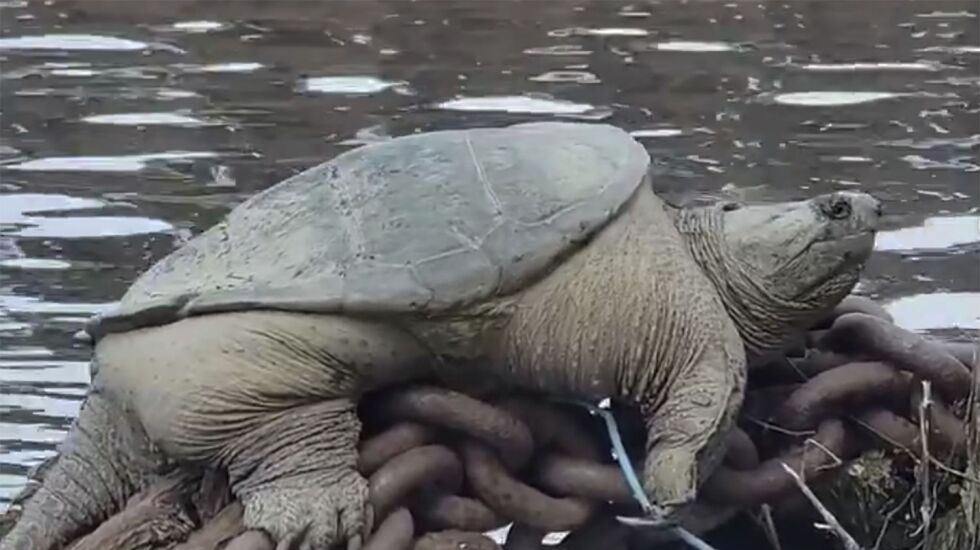
The man behind the viral video of a huge snapping turtle nicknamed “Chonkosaurus” catching sunbeams along the Chicago River said the sighting points to the improving health of the historically polluted waterway.
Joey Santore and his friend Al Scorch were kayaking and filming a video on plants growing along the river when they came upon the massive reptile lounging on the water near Goose Island.
Everything about the video screams Chicago, from the previously polluted stream of water to Santore’s recognizable accent as he marvels at the turtle’s size.
“That’s a Chicago river snapper,” Santore’s friend comments from the background. “Are you kidding me?”
The sight comes as a surprise as snapping turtles are rarely seen in Chicago until June, if at all, marine biologist Chris Anchor told NBC5. Yet, they are more common than most know. Chonkosaurus or “Chonko,” as it is known to online fans, may be the first of many snapping turtles to emerge as more Chicagoans take to the river.
Chicago River Snapper aka Chonkosaurus. Great to see this beast thriving here on what was once such a toxic river, but is slowly getting cleaned up & restored. Somebody planted a bunch of native plants up the river from here, too. I can only wonder this things been eating. pic.twitter.com/u6bhlpo4p5
— Joey Santore (@JoeySantore) May 6, 2023
“I’d seen snapping turtles before but never one that large,” Santore, a botanist, said Sunday. He added that he expected to see wildlife on the river, especially now that it’s less polluted, but he didn’t anticipate running into an animal of that size.
“As the industry has left, things have gotten a little more cleaned up, so I was expecting to see wildlife, but it was just the size and age of that thing that kind of shocked me,” he said.
In the 19th century the meatpacking and lumber industries used the river for shipping, and the waterway became a dumping ground for industries and for sewage. But the river’s quality has improved in recent years.
Santore said that snapping turtles can survive in “pretty nasty water,” but that seeing one that big not far from downtown is good news for wildlife that call the area home.
“Since people aren't dumping raw sewage and petrochemicals into it as much anymore it certainly seems like there’s life coming back,” Santore said.
Santore said he estimated Chonko weighs around 60 pounds, and its size indicates that it has roamed the water for at least a couple of decades.
“I’ve heard estimates of 40 or 50 years,” he said.
According to Friends of the Chicago River, there are two species of snapping turtles in North America, and both of them can be found in Illinois.
Margaret Frisbie, executive director of Friends of the Chicago River, said the health of the river is “dramatically” better than it was even 20 years ago.
“Water quality itself is much better, the temperature of the water, how much dissolved oxygen is in the river, how much sewage is in the river,” Frisbie said.
The organization has been working to increase turtle nesting habitat, which consists of loamy soils that are sandy, along the river. Frisbie said seeing large turtles is great, but seeing smaller ones is even better because it means they are reproducing.
Ryan Chew, founder and former owner of Chicago River Canoe and Kayak, said he’s seen snappers of all sizes while on the river, though not many in Chonko’s weight class.
Chew said he would often spot turtles in the north branch of the river, near Ravenswood, and its notable that Chonko was seen closer to downtown, where there is less of a habitat for wildlife.
“It’s always been a fairly natural setting upriver, but to see them moving into the area just north of the Loop is pretty impressive,” Chew said. “The idea that they’re living in new areas of the river that weren’t even habitat 15 years ago is neat to see.”
Santore said there were also other, less obvious signs that the river isn’t as polluted as it once was.
“There’s beavers, and there’s been a bunch of native fish returning,” Santore said, pointing to a floating wetlands project as one of the reasons why wildlife is beginning to flourish. “You bring the native plants back, and everything else starts coming back too.”
Chew credited the passage of the Clean Water Act in 1972 for helping clean up polluted rivers and protecting others.
“You need that kind of regulation to create a space like this because otherwise polluters can do whatever they want,” Chew said. “The efforts of volunteers, organizations and the city have transformed some of these spaces that 15, 20 years ago were basically two metal walls along the river.”
Frisbie said the river has had a negative reputation, and people are often surprised about its diversity of wildlife.
“There’s beavers, there’s muskrats, we see minks, there’s occasionally river otters, Frisbie said. “We encourage people to go out and look. Get out to a forest preserve, go to a river-edge park, sit still and you’ll just see some pretty magical stuff.”







